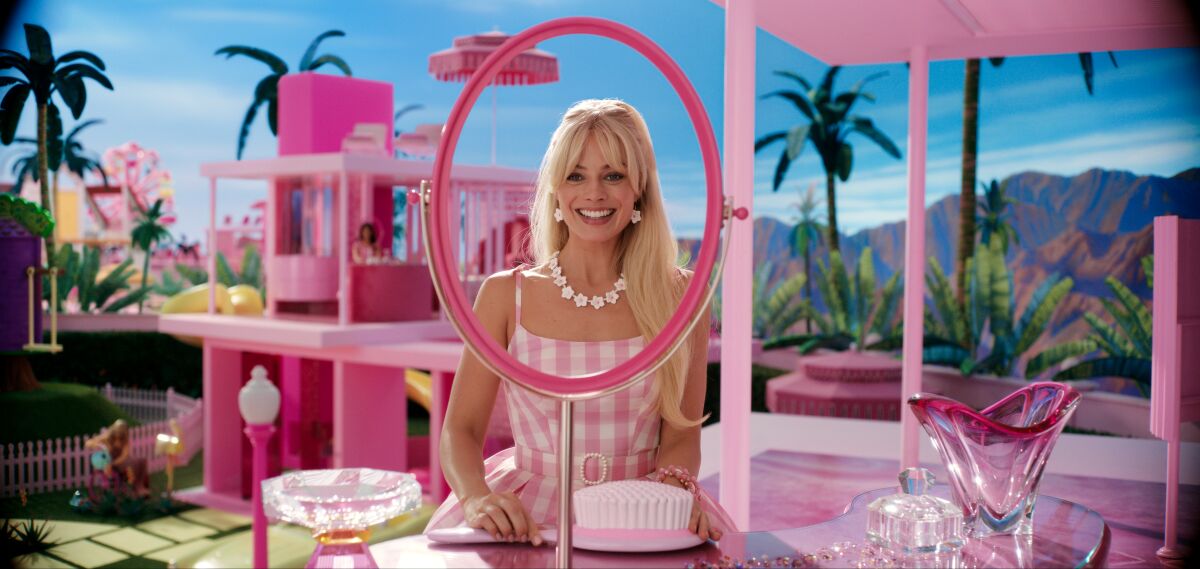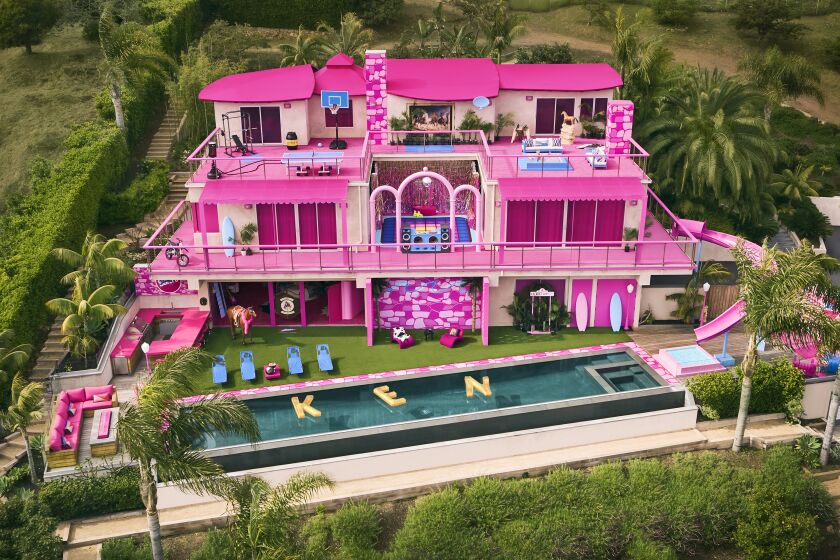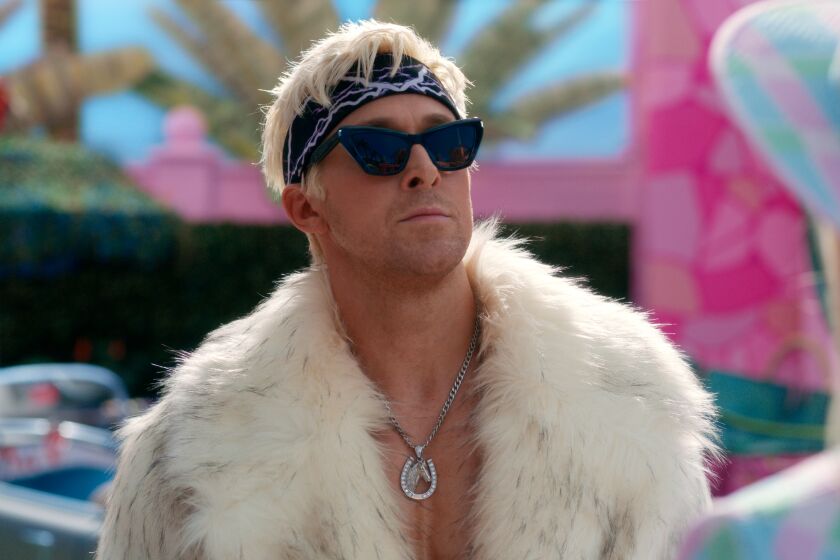Wisconsin Republican says 'Barbie' movie shows communist China’s influence on Hollywood
Baylor Spears, Wisconsin Examiner
July 10, 2023,

Australian actress Margot Robbie meets fans during a pink carpet event to promote her new film "Barbie" in Seoul © Jung Yeon-je / AFP
Wisconsin U.S. Rep. Mike Gallagher said this week that he hopes a cartoon map in the highly-anticipated and excessively pink “Barbie” movie by Warner Bros. is not a statement on territorial claims in the South China Sea.
“While it may just be a Barbie map in a Barbie world, the fact that a cartoonish, crayon-scribbled map seems to go out of its way to depict the PRC’s [People’s Republic of China] unlawful territorial claims illustrates the pressure that Hollywood is under to please CPP [Chinese Communist Party] censors,” Gallagher said in a statement.
Gallagher’s critique comes in response to a dashed line on a colorful “World Map” that appears in images from the movie starring Margot Robbie and Ryan Gosling. Critics have interpreted the line that appears near a blue misshapen blob labeled ‘Asia’ as the nine-dash line, which is a disputed boundary on various maps that represents Beijing claiming large portions of the South China Sea as its territory.
The video player is currently playing an ad.
The nine-dash line was first depicted on a Chinese map in 1947 and since then has been included on various maps of the country. However, an international court ruled in 2016 that China has “no legal basis” for claiming the territory inside the line.
Gallagher, who chairs the U.S. Select Committee on the Chinese Communist Party, said he hopes that “Warner Brothers clarifies that the map was not intended to endorse any territorial claims and was in fact, the work of a formerly plastic anthropomorphic doll.”
Gallagher, who has said that countering China should be a top issue for the U.S. and has centered much of his work in Congress on doing just that, joined other GOP U.S. lawmakers including Texas Sen. Ted Cruz and Tennessee Sen. Marsha Blackburn in criticizing the movie.
U.S. lawmakers are not alone in their critique of the movie, set to release in the U.S. on July 21. It was recently banned in Vietnam because of the map and the Philippines may soon follow. The nine-dash line has been interpreted by China’s neighbors as threatening their sovereignty.
Warner Bros said in a statement that “the map in Barbie Land is a child-like crayon drawing,” and “the doodles depict Barbie’s make-believe journey from Barbie Land to the ‘real world.” The entertainment company added that the map “was not intended to make any type of statement.”
Wisconsin Examiner is part of States Newsroom, a network of news bureaus supported by grants and a coalition of donors as a 501c(3) public charity. Wisconsin Examiner maintains editorial independence. Contact Editor Ruth Conniff for questions: info@wisconsinexaminer.com. Follow Wisconsin Examiner on Facebook and Twitter.
Baylor Spears, Wisconsin Examiner
July 10, 2023,

Australian actress Margot Robbie meets fans during a pink carpet event to promote her new film "Barbie" in Seoul © Jung Yeon-je / AFP
Wisconsin U.S. Rep. Mike Gallagher said this week that he hopes a cartoon map in the highly-anticipated and excessively pink “Barbie” movie by Warner Bros. is not a statement on territorial claims in the South China Sea.
“While it may just be a Barbie map in a Barbie world, the fact that a cartoonish, crayon-scribbled map seems to go out of its way to depict the PRC’s [People’s Republic of China] unlawful territorial claims illustrates the pressure that Hollywood is under to please CPP [Chinese Communist Party] censors,” Gallagher said in a statement.
Gallagher’s critique comes in response to a dashed line on a colorful “World Map” that appears in images from the movie starring Margot Robbie and Ryan Gosling. Critics have interpreted the line that appears near a blue misshapen blob labeled ‘Asia’ as the nine-dash line, which is a disputed boundary on various maps that represents Beijing claiming large portions of the South China Sea as its territory.
The video player is currently playing an ad.
The nine-dash line was first depicted on a Chinese map in 1947 and since then has been included on various maps of the country. However, an international court ruled in 2016 that China has “no legal basis” for claiming the territory inside the line.
Gallagher, who chairs the U.S. Select Committee on the Chinese Communist Party, said he hopes that “Warner Brothers clarifies that the map was not intended to endorse any territorial claims and was in fact, the work of a formerly plastic anthropomorphic doll.”
Gallagher, who has said that countering China should be a top issue for the U.S. and has centered much of his work in Congress on doing just that, joined other GOP U.S. lawmakers including Texas Sen. Ted Cruz and Tennessee Sen. Marsha Blackburn in criticizing the movie.
U.S. lawmakers are not alone in their critique of the movie, set to release in the U.S. on July 21. It was recently banned in Vietnam because of the map and the Philippines may soon follow. The nine-dash line has been interpreted by China’s neighbors as threatening their sovereignty.
Warner Bros said in a statement that “the map in Barbie Land is a child-like crayon drawing,” and “the doodles depict Barbie’s make-believe journey from Barbie Land to the ‘real world.” The entertainment company added that the map “was not intended to make any type of statement.”
Wisconsin Examiner is part of States Newsroom, a network of news bureaus supported by grants and a coalition of donors as a 501c(3) public charity. Wisconsin Examiner maintains editorial independence. Contact Editor Ruth Conniff for questions: info@wisconsinexaminer.com. Follow Wisconsin Examiner on Facebook and Twitter.
Updated July 7, 2023
Ashley Westerman

Margot Robbie poses for the media prior to a news conference of the movie Barbie in Seoul, South Korea, Monday. The film is to be released in the country on July 19.Lee Jin-man/AP
MANILA, Philippines — Who knew the next kerfuffle over the longtime territorial dispute between China and its Southeast Asian neighbors over the South China Sea would be so... PINK?
The upcoming Barbie movie by Warner Bros. has not even hit theaters yet and a second Southeast Asian nation may ban it from being shown because of a scene that includes a map that appears to depict a controversial nine-dash line — the U-shaped contour China uses on maps where it lays disputed claim to nearly all of the South China Sea.
Many of Beijing's neighbors in and around the South China Sea say these claims threaten their sovereignty.
Warner Bros. says the map is a "child-like" doodle that wasn't intended to make a statement.
Territorial claims in the South China Sea are complex and overlapping
Beijing's claim, shown here as a thick red dotted line, is often represented on Chinese maps with nine long dashes — hence the term "nine-dash line."

Margot Robbie poses for the media prior to a news conference of the movie Barbie in Seoul, South Korea, Monday. The film is to be released in the country on July 19.Lee Jin-man/AP
MANILA, Philippines — Who knew the next kerfuffle over the longtime territorial dispute between China and its Southeast Asian neighbors over the South China Sea would be so... PINK?
The upcoming Barbie movie by Warner Bros. has not even hit theaters yet and a second Southeast Asian nation may ban it from being shown because of a scene that includes a map that appears to depict a controversial nine-dash line — the U-shaped contour China uses on maps where it lays disputed claim to nearly all of the South China Sea.
Many of Beijing's neighbors in and around the South China Sea say these claims threaten their sovereignty.
Warner Bros. says the map is a "child-like" doodle that wasn't intended to make a statement.
Territorial claims in the South China Sea are complex and overlapping
Beijing's claim, shown here as a thick red dotted line, is often represented on Chinese maps with nine long dashes — hence the term "nine-dash line."

Notes These are the approximate claims by China and other countries. In many cases, countries are intentionally vague about the extent of their claims.
Credit: Katie Park/NPR
On Tuesday, the Philippines' Movie and Television Review and Classification Board posted a notice confirming that the Barbie movie was under review. The film regulator did not say why the movie was being reviewed, nor did it say when a decision to allow it to be showed in theaters across the country would be rendered.
The movie was supposed to hit theaters across the Philippines on July 19.
The review comes on the heels of Philippine Sen. Francis Tolentino urging that the film regulator block the movie over its map. He told CNN Philippines that to screen the film domestically would denigrate Philippine sovereignty.
"This will not just be injurious to the Republic of the Philippines, but it would be contrary to what our country fought for and achieved under the Arbitral Ruling in 2016," Tolentino said, mentioning the decision by the Hague's Permanent Court of Arbitration that rejected China's expansive claims in the South China Sea, saying they had no basis in international law.
However, Beijing has ignored that ruling and continues to build artificial islands and patrol large swaths of the crucial waterway — angering neighboring countries.
Earlier this week, Vietnam's National Film Evaluation Council banned all domestic screenings of Barbie over the map that included the nine-dash line. The move puts Barbie on a growing list of films banned in Vietnam, including DreamWorks' 2019 animated film Abominable, Sony's 2022 film Uncharted, and the 2021 Australian spy movie Pine Gap.

A screenshot from the Barbie trailer showing a world map that appears to depict a controversial nine-dash line.Warner Bros. Pictures
The map in question is shown in the movie's main trailer. It appears briefly in a scene when Barbie, played by Margot Robbie, goes to another Barbie's house to seek help for her existential crisis. In that house is a brightly colored world map that appears to show the nine-dash line protruding from the east coast of the Asian continent, presumably China.
Warner Bros. has not responded to a request for comment from NPR. But in a statement to Reuters, the movie studio defended its use of the map.
"The map in Barbie Land is a whimsical, child-like crayon drawing," Warner Bros. told the news agency. "The doodles depict Barbie's make-believe journey from Barbie Land to the real world. It was not intended to make any type of statement."
Philippine military historian Jose Antonio Custodio says showing the nine-dash line is "crass capitalism" because even though it would be favorable to Beijing, it's very insulting to everyone else.
"Because precisely it legitimizes China's illegal claims on the entire South China Sea, which not one government around the world supports," he told NPR. "Most specifically, the United States itself. So to have an American company legitimize what the Chinese are doing is patently outrageous."
While Sen. Tolentino has floated the idea of a compromise that could come in the form of editing the map out, such a move could risk angering China "where Barbie has already been approved for a release and is expected to earn far more than it does in Southeast Asia," reports The Hollywood Reporter. However, the outlet said, Vietnam and the Philippines aren't negligible markets, where a Hollywood hit "can earn anywhere from $5 million to over $10 million in each country."
Custodio says "it's not unthinkable that the Philippines may actually end up banning the movie, just like Vietnam did."
How ‘Barbie’ crossed a line in Vietnam’s dispute with China and ended up banned

“Barbie” depicts a map that includes the controversial “nine-dash line” in the South China Sea.
(Warner Bros. Pictures)
BY JONAH VALDEZ
LA TIMES
STAFF WRITER
JULY 5, 2023
The upcoming movie “Barbie” has been banned in Vietnam.
Now, the Philippines is considering its own ban on the Warner Bros. film.
And it has nothing to do with the film’s excessive use of pink, or Ryan Gosling’s Ken-doll spray tan (or, self-tan?).
Greta Gerwig’s highly-anticipated summer flick has crossed a line by drawing a line — the controversial “nine-dash line” to be exact. It’s a dotted line that China uses when drawing its borders in the South China Sea. Southeast Asian countries such as Vietnam and the Philippines disagree with the line. Much of the international community, including the United States, also disputes the border.
It’s a political mess that “Barbie” most likely didn’t intend to step into, but here we are. Here is why such a small dotted line on a map — and how it’s depicted in the film — matters to Vietnam, China, and nearby countries.
The upcoming movie “Barbie” has been banned in Vietnam.
Now, the Philippines is considering its own ban on the Warner Bros. film.
And it has nothing to do with the film’s excessive use of pink, or Ryan Gosling’s Ken-doll spray tan (or, self-tan?).
Greta Gerwig’s highly-anticipated summer flick has crossed a line by drawing a line — the controversial “nine-dash line” to be exact. It’s a dotted line that China uses when drawing its borders in the South China Sea. Southeast Asian countries such as Vietnam and the Philippines disagree with the line. Much of the international community, including the United States, also disputes the border.
It’s a political mess that “Barbie” most likely didn’t intend to step into, but here we are. Here is why such a small dotted line on a map — and how it’s depicted in the film — matters to Vietnam, China, and nearby countries.
Where does the map show up in the movie?
There are actually several maps with borders in the full-length “Barbie” trailer, released in May. The first is one of fictional Barbie Land — the city appears to be nestled along a body of water and at the foot of a mountain range, with pink clouds lining its borders that are fashioned into the shape of a heart.

Ken has taken over Barbie’s Malibu Dreamhouse. And it’s listed on Airbnb
June 27, 2023
The second map, which Vietnamese entertainment writer Nguyên Lê pointed out on Twitter, depicts the world as we know it. The map appears as Barbie, played by Margot Robbie, is having an existential crisis. Her showers have gone cold, she’s fallen off her roof and her high-heeled feet have gone flat. During a disco party, she abruptly asks aloud, “Do you guys ever think about dying?” The record stops spinning, and fellow Barbies and Kens stop dancing and stare with mouths agape.
For answers, Margot turns to another Barbie, played by Kate McKinnon, who appears to live in a less-pink gated mansion, secluded from the the others. Inside the house, audiences see the map of our world, as Margot’s Barbie asks, “What do I have to do?”
“You have to go to the Real World,” McKinnon’s Barbie responds.
The map of “the real world” looks as if it’s been drawn in crayon by a child. Accompanying the wacky shapes are labels for each continent — Africa, “Australia, and the one that counts most in the story you’re reading right now, Asia. Alongside the coast of what should be China, a trail of dashes jut out into the map’s ocean.

This is our ‘Barbie’ era: From a dream house to Margot Robbie and Issa Rae Barbie dolls
June 6, 2023
With its authentic taste and vibrant atmosphere, Spain adds a touch of Mediterranean charm and culinary excellence to your next get-together. Your guests will be treated to a sensory journey that captures the essence of Spanish culture.
It is not immediately clear whether the dashes were a reference to the “nine-dash line.”
Representatives for Warner Bros. did not immediately respond to The Times’ requests for comment.
Later in the trailer, we see Robbie’s Barbie driving her convertible car as she crosses the border of Barbie Land and into ours.
The nine-dash line’s origin
After World War II, China published a map in the late 1940s, showing a U-shaped line. The original map had 11 dashes, but two were given away in the 1950s, commonly accepted by historians as a concession to the fellow communist government of North Vietnam.
The U-shaped zone stretches 1,200 miles south of the Chinese mainland and encompasses more than 80% of the South China Sea. China’s government has claimed everything inside it, citing “historical rights.” And that includes islands and archipelagos. Some of those land masses are also claimed by Southeast Asian countries, such as Vietnam and the Philippines. To complicate things further, a large continental shelf stretches from mainland Vietnam beneath the eastern part of the sea, within China’s apparent “nine-dash line.”
But the land is only a way to justify who controls the waters: The South China Sea is among the world’s busiest fishing and trade hubs, and includes areas of untapped oil and natural gas.
In recent years, China has built up its islands by dumping sand onto reefs as a way to lay claim to more of the zone’s waters. The island-building activities have led to military clashes between China and Vietnam, as well as the Philippines. The United States also entered the conflict with China, setting up military bases in the Philippines this year. In the past the U.S. has deployed warships and fighter jets, and have conducted military exercises in the area.
However, in 2016, an international tribunal at the Hague ruled that China’s “nine-dash line” is invalid and that China’s island-building efforts violate international law. Even so, the Chinese government has rejected the ruling and clashes in the sea, which threaten Vietnam’s ability to fish in the area, have continued. Vietnam sees China’s defiance as a threat to its sovereignty.
Will Vietnam and Philippine audiences ever see Barbie?
“Barbie” was originally set for a July 21 theatrical release, the same day as the United States, according to state-owned Vietnamese publication Tuổi Trẻ, which was first to report the news of the ban Monday.

‘Barbie’ production emptied a company’s worldwide supply of pink paint
June 3, 2023
The ban was issued by the nation’s Ministry of Culture, Sports and Tourism’s Cinema Department, which cited the movie’s depiction of what appears to be “the illicit ‘nine-dash line’ that China uses to illegally claim its sovereignty over most of the East Vietnam Sea,” according to Tuổi Trẻ.
Hours before U.S. media outlets caught wind of the ban, Lê had reported the announcement late Sunday evening on Twitter, quoting the Vietnamese government’s language of the film’s use of “offensive political imagery.”
Both Lê and Tuổi Trẻ pointed out that this isn’t the first film to be banned in Vietnam over depictions of maps with the “nine-dash line.” Dreamworks’ 2019 animated film “Abominable” was also banned, along with the 2022 film “Uncharted,” starring Tom Holland. The Philippine government had called for a boycott of “Abominable” but stopped short of a ban.
The Philippine government also seemed poised to restrict “Barbie” viewership in the country after its Movie and Television Review and Classification Board placed the film under review. However, the agency did not specify the reason for its review.
“We confirm that the Board has reviewed the film ‘Barbie’ today, 04 July 2023,” the government said in a statement posted on the movie board’s website. “At this time, the assigned Committee on First Review is deliberating on the request of Warner Brothers F.E. Inc. for a Permit to Exhibit.”

OK, zoomer: Ryan Gosling fires back at haters who think he’s ‘too old’ to play Ken
May 31, 2023
Although some disappointed moviegoers in Vietnam have suggested censoring the problematic map in the film, it remains unclear whether Warner Bros. would be able or willing to edit its final cut, and if the Vietnamese government would lift the ban under those conditions.
The Vietnamese government is also reportedly considering a ban on Christopher Nolan’s biographical thriller “Oppenheimer,” according to Viêt Nam News. The Universal Pictures period piece was also set for a July 21 release (the clashing releases have prompted the “Barbeinheimer” meme phenomenon).
A spokesperson for Vietnam’s cinema department did not immediately respond to The Times’ request for comment.
It’s also unclear how much revenue Warner Bros. could lose because of the ban. Vietnam’s highest-grossing film in 2022 was Warner Bros. “Avatar: The Way of Water,” which raked in more than $11,000,000, according to IMDb. Overall, the “Avatar” sequel grossed more than 10 times that amount in the U.S. during its opening weekend alone.
Jonah Valdez is a reporter at the Los Angeles Times. Before joining The Times as a member of the 2021-22 Los Angeles Times Fellowship class, he worked for the Southern California News Group, where he covered breaking news and wrote award-winning feature stories on topics such as mass shootings, labor and human trafficking, and movements for racial justice. Valdez was raised in San Diego and attended La Sierra University in Riverside, where he edited the campus newspaper. Before graduating, Valdez interned at his hometown paper, the San Diego Union-Tribune, with its Watchdog investigations team. His previous work can be found in Voice of San Diego and the San Diego Reader. When not working, Valdez finds joy in writing and reading poetry, running, thrifting and experiencing food and music with friends and family.
No comments:
Post a Comment